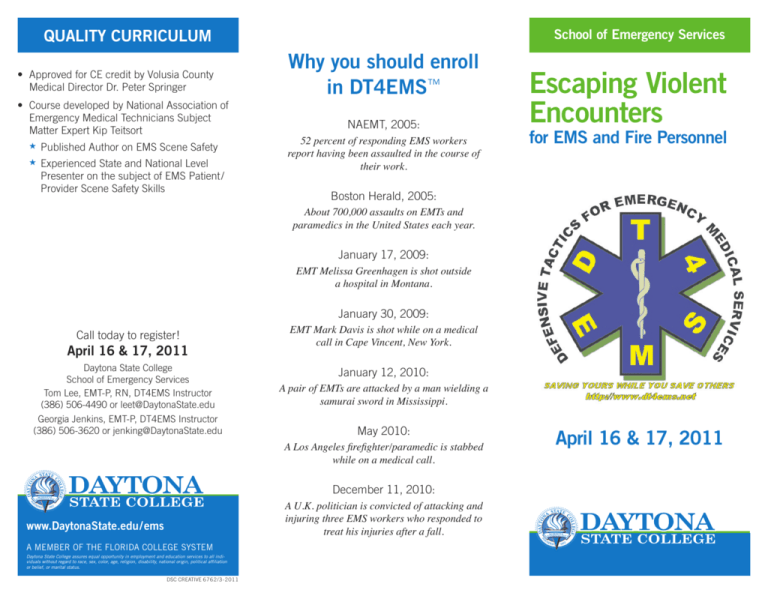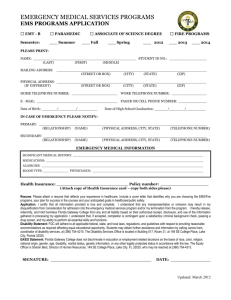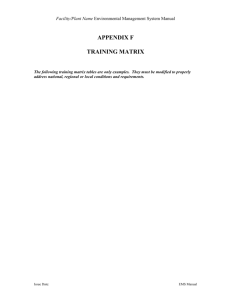Escaping Violent Encounters
advertisement

QUALITY CURRICULUM • Approved for CE credit by Volusia County Medical Director Dr. Peter Springer • Course developed by National Association of Emergency Medical Technicians Subject Matter Expert Kip Teitsort H Published Author on EMS Scene Safety H Experienced State and National Level Presenter on the subject of EMS Patient/ Provider Scene Safety Skills School of Emergency Services Why you should enroll in DT4EMS™ NAEMT, 2005: 52 percent of responding EMS workers report having been assaulted in the course of their work. Escaping Violent Encounters for EMS and Fire Personnel Boston Herald, 2005: About 700,000 assaults on EMTs and paramedics in the United States each year. January 17, 2009: EMT Melissa Greenhagen is shot outside a hospital in Montana. January 30, 2009: Call today to register! April 16 & 17, 2011 Daytona State College School of Emergency Services Tom Lee, EMT-P, RN, DT4EMS Instructor (386) 506-4490 or leet@DaytonaState.edu Georgia Jenkins, EMT-P, DT4EMS Instructor (386) 506-3620 or jenking@DaytonaState.edu EMT Mark Davis is shot while on a medical call in Cape Vincent, New York. January 12, 2010: A pair of EMTs are attacked by a man wielding a samurai sword in Mississippi. May 2010: A Los Angeles firefighter/paramedic is stabbed while on a medical call. December 11, 2010: A U.K. politician is convicted of attacking and injuring three EMS workers who responded to treat his injuries after a fall. www.DaytonaState.edu/ems a member of the florida college system Daytona State College assures equal opportunity in employment and education services to all individuals without regard to race, sex, color, age, religion, disability, national origin, political affiliation or belief, or marital status. DSC CREATIVE 6 7 6 2 / 3 - 2 0 1 1 April 16 & 17, 2011 Escaping Violent Encounters for EMS and Fire Personnel April 16 & 17, 2011 Have you or your staff ever been threatened, yelled at or physically assaulted by a patient, upset family member or bystander? Research shows that injuries from assaults are a leading cause of lost work hours in EMS. This course is for EMS managers and their staff who are interested in learning about how to respond to such particularly stressful incidents. Our Defensive Tactics for Emergency Medical Services (DT4EMSTM) Escaping Violent Encounters course can help keep you and your staff safe. Our training emphasizes good customer service practices, and teaches proven verbal skills to be used before, during and after an incident. The course also teaches the use of reasonable force as a last resort, providing real-world skills to free EMS providers from actual physical assaults should they occur. Topics covered include: • Dispatch to Scene Indicators • Arrival Scene Indicators • Laws of Self Defense • Assault Response Guidelines • Laws of Patient Restraint • Assault Response Problem Solving • Escape Skills • Basic Pressure Distraction Points • Pre-Assault Indicators • Proper Documentation • Patient vs. Attacker Recognition • Physical Fitness in EMS What you will learn: Liability Awareness In addition to training in the limits to force and restraint by EMS personnel, participants will learn articulation and documentation skills that will hold up to scrutiny in any legal or ethical venue. Sound decisions in the face of a dangerous assault by a patient, and the articulation skills to prove the reasonableness of those responses, will reduce the EMS professional’s exposure to liability in any situation. Your personnel face the daily prospect of assault and injury. Without training, they will resort to improvised methods of defense and restraint. Their improvisation may later be found to be unreasonable, and sometimes even have criminal liability. Additionally, as their employer, your agency or company may be exposed to tremendous civil liability as a result of their actions. DT4EMS™ provides “Assault Response Guidelines” for those instances when prevention and avoidance are just not enough. Practical Techniques Our system of assault avoidance and response is designed to be relevant to every member of your staff – big or small, strong or less so, male or female, trained in defense skills or not. We don’t teach fancy techniques that are forgotten even before the student leaves the classroom. Instead, we teach your personnel to problem-solve the situation confronting them using verbal conflict resolution, deflection and de-escalation techniques, as well as physical tactics that are easy to recall and easily performed by anyone. These are proven skills that can help EMS personnel avoid and escape dangerous situations, even under stress.






